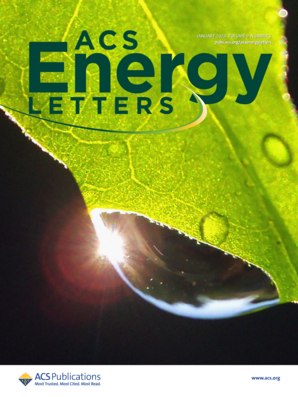Regulating the Crystallization Process of Intermediate Phase for Wide-Bandgap Perovskite Reduces Open-Circuit Voltage Deficit
IF 19.3
1区 材料科学
Q1 CHEMISTRY, PHYSICAL
引用次数: 0
Abstract
Wide-bandgap (WBG) perovskite solar cells with a bandgap exceeding 1.65 eV effectively complement the spectral response of monocrystalline silicon, making them promising candidates for high-performance perovskite–silicon tandem cells. However, achieving WBG perovskites with a bandgap of 1.65 eV typically requires a Br-rich composition, which often results in severe light-induced I–Br phase segregation. In this work, a Cs-rich composition, FA0.5Cs0.5Pb(I0.93Br0.07)3 perovskite with a bandgap of 1.65 eV, was studied and an arylformamidium additive-assisted approach was adopted to regulate the crystallization process of the intermediate phase. The arylformamidium molecules selectively adsorb onto the Cs2PbI2Cl2 intermediate grains, inhibiting the interplay between DMSO and Cs2PbI2Cl2, significantly increasing the grain size of intermediate-phase Cs2PbI2Cl2 and improving its crystallinity. The highly uniform Cs2PbI2Cl2 intermediate grains enhance the nucleation consistency and growth uniformity of the perovskite, ultimately forming a homogeneous perovskite film with large grain sizes and preferential orientation, while reducing the defect state densities. As a result, the 2-thienformamidium iodide (TFAI)-modified WBG perovskite solar cells achieved a power conversion efficiency (PCE) of 21.94%, alongside an impressive open-circuit voltage of 1.27 V. Moreover, the devices retained over 90% of their initial PCE after >1000 h of maximum power point (MPP) tracking degradation testing, and negligible phase segregation was detected after 450 h of AM 1.5G illumination.

求助全文
约1分钟内获得全文
求助全文
来源期刊

ACS Energy Letters
Energy-Renewable Energy, Sustainability and the Environment
CiteScore
31.20
自引率
5.00%
发文量
469
审稿时长
1 months
期刊介绍:
ACS Energy Letters is a monthly journal that publishes papers reporting new scientific advances in energy research. The journal focuses on topics that are of interest to scientists working in the fundamental and applied sciences. Rapid publication is a central criterion for acceptance, and the journal is known for its quick publication times, with an average of 4-6 weeks from submission to web publication in As Soon As Publishable format.
ACS Energy Letters is ranked as the number one journal in the Web of Science Electrochemistry category. It also ranks within the top 10 journals for Physical Chemistry, Energy & Fuels, and Nanoscience & Nanotechnology.
The journal offers several types of articles, including Letters, Energy Express, Perspectives, Reviews, Editorials, Viewpoints and Energy Focus. Additionally, authors have the option to submit videos that summarize or support the information presented in a Perspective or Review article, which can be highlighted on the journal's website. ACS Energy Letters is abstracted and indexed in Chemical Abstracts Service/SciFinder, EBSCO-summon, PubMed, Web of Science, Scopus and Portico.
 求助内容:
求助内容: 应助结果提醒方式:
应助结果提醒方式:


